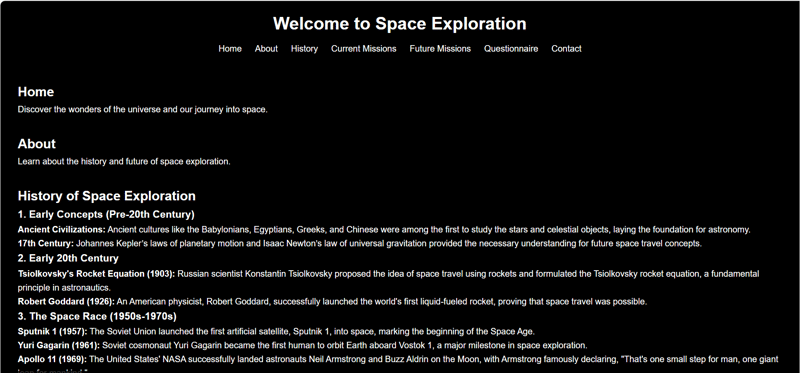前端尝试
这是前端挑战 v24.09.04 的提交内容,美化我的标记:Space
我建造了什么
我构建了一个以太空为主题的登陆页面,提供有关太空探索的信息。目标是创造一个有吸引力的简约设计,突出太空历史、当前任务、未来任务等的关键方面。该页面包括主页、关于、历史、当前任务、未来任务、调查问卷和联系信息等部分。
演示
您可以在此处实时查看该项目。以下是登陆页面的屏幕截图:

太空探索登陆页面
您也可以在Github上查看代码
旅程
创建这个项目是一次令人兴奋的旅程。以下是有关该过程的一些要点:
设计和布局:我的目标是干净简约的设计,带有黑暗的太空主题背景,以创造身临其境的体验。布局简单但信息丰富,使用户可以轻松浏览不同的部分。
内容:我包含了有关太空探索历史、当前和未来任务的详细信息。问卷部分允许用户互动并分享他们对太空探索的想法。
挑战:挑战之一是确保动画交互在不同设备和屏幕尺寸上顺利运行。在这个过程中我学到了很多关于响应式设计和跨浏览器兼容性的知识。
未来计划:我计划添加更多互动元素,例如有关太空事实的测验和太空探索中重大事件的时间表。我也希望整合更高级的动画和转场,让页面更加吸引人。
代码
HTML
<!DOCTYPE html>
<html lang="en">
<head>
<meta charset="UTF-8">
<meta name="viewport" content="width=device-width, initial-scale=1.0">
<title>Space Exploration</title>
<link rel="stylesheet" href="styles.css">
</head>
<body>
<header class="space-background">
<h1>Welcome to Space Exploration</h1>
<nav>
<ul>
<li><a href="#home">Home</a></li>
<li><a href="#about">About</a></li>
<li><a href="#history">History</a></li>
<li><a href="#current-missions">Current Missions</a></li>
<li><a href="#future-missions">Future Missions</a></li>
<li><a href="#questionnaire">Questionnaire</a></li>
<li><a href="#contact">Contact</a></li>
</ul>
</nav>
</header>
<main class="space-background">
<section id="home">
<h2>Home</h2>
<p>Discover the wonders of the universe and our journey into space.</p>
</section>
<section id="about">
<h2>About</h2>
<p>Learn about the history and future of space exploration.</p>
</section>
<section id="history">
<h2>History of Space Exploration</h2>
<h3>1. Early Concepts (Pre-20th Century)</h3>
<p><strong>Ancient Civilizations:</strong> Ancient cultures like the Babylonians, Egyptians, Greeks, and Chinese were among the first to study the stars and celestial objects, laying the foundation for astronomy.</p>
<p><strong>17th Century:</strong> Johannes Kepler’s laws of planetary motion and Isaac Newton’s law of universal gravitation provided the necessary understanding for future space travel concepts.</p>
<h3>2. Early 20th Century</h3>
<p><strong>Tsiolkovsky's Rocket Equation (1903):</strong> Russian scientist Konstantin Tsiolkovsky proposed the idea of space travel using rockets and formulated the Tsiolkovsky rocket equation, a fundamental principle in astronautics.</p>
<p><strong>Robert Goddard (1926):</strong> An American physicist, Robert Goddard, successfully launched the world's first liquid-fueled rocket, proving that space travel was possible.</p>
<h3>3. The Space Race (1950s-1970s)</h3>
<p><strong>Sputnik 1 (1957):</strong> The Soviet Union launched the first artificial satellite, Sputnik 1, into space, marking the beginning of the Space Age.</p>
<p><strong>Yuri Gagarin (1961):</strong> Soviet cosmonaut Yuri Gagarin became the first human to orbit Earth aboard Vostok 1, a major milestone in space exploration.</p>
<p><strong>Apollo 11 (1969):</strong> The United States' NASA successfully landed astronauts Neil Armstrong and Buzz Aldrin on the Moon, with Armstrong famously declaring, "That's one small step for man, one giant leap for mankind."</p>
<h3>4. Post-Moon Landings and the Space Shuttle Era (1970s-1990s)</h3>
<p><strong>Space Stations:</strong></p>
<ul>
<li><strong>Salyut and Mir (1971-1986):</strong> The Soviet Union launched a series of space stations, culminating in the long-lasting Mir, which operated until 2001.</li>
<li><strong>Skylab (1973):</strong> The United States launched its first space station, Skylab, which was operational for six years.</li>
</ul>
<p><strong>Space Shuttle Program (1981-2011):</strong> NASA’s reusable Space Shuttle fleet completed 135 missions over 30 years, including launching satellites, conducting scientific research, and assembling the International Space Station (ISS).</p>
<h3>5. International Cooperation and Space Exploration (1990s-Present)</h3>
<p><strong>International Space Station (ISS) (1998-present):</strong> A joint effort by NASA, Roscosmos (Russia), ESA (Europe), JAXA (Japan), and other partners, the ISS serves as a hub for scientific research and international collaboration in low Earth orbit.</p>
<p><strong>Mars Exploration:</strong></p>
<ul>
<li><strong>Rovers and Orbiters:</strong> The Mars rovers like Spirit, Opportunity, Curiosity, and Perseverance have provided detailed information about the Martian surface and its potential to support life.</li>
<li><strong>ExoMars (2020):</strong> A European-Russian mission designed to search for signs of life on Mars.</li>
</ul>
<h3>6. Private Space Exploration and the Future (2000s-Present)</h3>
<p><strong>Commercial Spaceflight:</strong> Companies like SpaceX, Blue Origin, and Virgin Galactic are pioneering commercial space travel, aiming to make space more accessible to private individuals and researchers.</p>
</section>
<section id="current-missions">
<h2>Current Missions</h2>
<p>Explore the ongoing missions that are expanding our understanding of the universe.</p>
</section>
<section id="future-missions">
<h2>Future Missions</h2>
<p>Learn about the upcoming missions that aim to push the boundaries of space exploration.</p>
</section>
<section id="questionnaire">
<h2>Questionnaire</h2>
<form>
<label for="name">Name:</label>
<input type="text" id="name" name="name" required><br><br>
<label for="email">Email:</label>
<input type="email" id="email" name="email" required><br><br>
<label for="question1">1. What is your favorite planet?</label><br>
<input type="text" id="question1" name="question1" required><br><br>
<label for="question2">2. Have you ever visited a space museum?</label><br>
<input type="radio" id="yes" name="question2" value="yes">
<label for="yes">Yes</label><br>
<input type="radio" id="no" name="question2" value="no">
<label for="no">No</label><br><br>
<label for="question3">3. What interests you the most about space exploration?</label><br>
<textarea id="question3" name="question3" rows="4" cols="50" required></textarea><br><br>
<input type="submit" value="Submit">
</form>
</section>
<section id="contact">
<h2>Contact</h2>
<p>Get in touch with us for more information about space exploration.</p>
</section>
</main>
<footer class="space-background">
<p>© 2024 Space Exploration. All rights reserved.</p>
</footer>
</body>
</html>
CSS
* {
margin: 0;
padding: 0;
box-sizing: border-box;
}
body {
font-family: Arial, sans-serif;
line-height: 1.6;
background-color: #000;
color: #fff;
}
.space-background {
background: rgba(0, 0, 0, 0.8) url('https://www.nasa.gov/sites/default/files/thumbnails/image/potw2048a.jpg') no-repeat center center;
background-size: cover;
}
header {
padding: 1rem 0;
text-align: center;
}
header h1 {
margin-bottom: 0.5rem;
}
nav ul {
list-style: none;
padding: 0;
}
nav ul li {
display: inline;
margin: 0 10px;
}
nav ul li a {
color: #fff;
text-decoration: none;
}
main {
padding: 2rem;
}
section {
margin-bottom: 2rem;
}
form {
background: rgba(255, 255, 255, 0.1);
padding: 1rem;
border-radius: 5px;
}
form label {
display: block;
margin-bottom: 0.5rem;
}
form input[type="text"],
form input[type="email"],
form textarea {
width: 100%;
padding: 0.5rem;
margin-bottom: 1rem;
border: none;
border-radius: 5px;
}
form input[type="submit"] {
background: #333;
color: #fff;
border: none;
padding: 0.5rem 1rem;
border-radius: 5px;
cursor: pointer;
}
form input[type="submit"]:hover {
background: #555;
}
footer {
text-align: center;
padding: 1rem 0;
position: fixed;
width: 100%;
bottom: 0;
}
团队
这个项目是一个人的努力,但我想归功于以下资源和灵感:
NASA 令人惊叹的太空图像。
MDN Web 文档,提供有关 Web 开发的优秀文档。
许可证
该项目根据 MIT 许可证获得许可。请随意使用和修改您认为合适的代码。
以上是前端尝试的详细内容。更多信息请关注PHP中文网其他相关文章!

热AI工具

Undresser.AI Undress
人工智能驱动的应用程序,用于创建逼真的裸体照片

AI Clothes Remover
用于从照片中去除衣服的在线人工智能工具。

Undress AI Tool
免费脱衣服图片

Clothoff.io
AI脱衣机

Video Face Swap
使用我们完全免费的人工智能换脸工具轻松在任何视频中换脸!

热门文章

热工具

记事本++7.3.1
好用且免费的代码编辑器

SublimeText3汉化版
中文版,非常好用

禅工作室 13.0.1
功能强大的PHP集成开发环境

Dreamweaver CS6
视觉化网页开发工具

SublimeText3 Mac版
神级代码编辑软件(SublimeText3)
 神秘的JavaScript:它的作用以及为什么重要
Apr 09, 2025 am 12:07 AM
神秘的JavaScript:它的作用以及为什么重要
Apr 09, 2025 am 12:07 AM
JavaScript是现代Web开发的基石,它的主要功能包括事件驱动编程、动态内容生成和异步编程。1)事件驱动编程允许网页根据用户操作动态变化。2)动态内容生成使得页面内容可以根据条件调整。3)异步编程确保用户界面不被阻塞。JavaScript广泛应用于网页交互、单页面应用和服务器端开发,极大地提升了用户体验和跨平台开发的灵活性。
 JavaScript的演变:当前的趋势和未来前景
Apr 10, 2025 am 09:33 AM
JavaScript的演变:当前的趋势和未来前景
Apr 10, 2025 am 09:33 AM
JavaScript的最新趋势包括TypeScript的崛起、现代框架和库的流行以及WebAssembly的应用。未来前景涵盖更强大的类型系统、服务器端JavaScript的发展、人工智能和机器学习的扩展以及物联网和边缘计算的潜力。
 JavaScript引擎:比较实施
Apr 13, 2025 am 12:05 AM
JavaScript引擎:比较实施
Apr 13, 2025 am 12:05 AM
不同JavaScript引擎在解析和执行JavaScript代码时,效果会有所不同,因为每个引擎的实现原理和优化策略各有差异。1.词法分析:将源码转换为词法单元。2.语法分析:生成抽象语法树。3.优化和编译:通过JIT编译器生成机器码。4.执行:运行机器码。V8引擎通过即时编译和隐藏类优化,SpiderMonkey使用类型推断系统,导致在相同代码上的性能表现不同。
 Python vs. JavaScript:学习曲线和易用性
Apr 16, 2025 am 12:12 AM
Python vs. JavaScript:学习曲线和易用性
Apr 16, 2025 am 12:12 AM
Python更适合初学者,学习曲线平缓,语法简洁;JavaScript适合前端开发,学习曲线较陡,语法灵活。1.Python语法直观,适用于数据科学和后端开发。2.JavaScript灵活,广泛用于前端和服务器端编程。
 JavaScript:探索网络语言的多功能性
Apr 11, 2025 am 12:01 AM
JavaScript:探索网络语言的多功能性
Apr 11, 2025 am 12:01 AM
JavaScript是现代Web开发的核心语言,因其多样性和灵活性而广泛应用。1)前端开发:通过DOM操作和现代框架(如React、Vue.js、Angular)构建动态网页和单页面应用。2)服务器端开发:Node.js利用非阻塞I/O模型处理高并发和实时应用。3)移动和桌面应用开发:通过ReactNative和Electron实现跨平台开发,提高开发效率。
 如何使用Next.js(前端集成)构建多租户SaaS应用程序
Apr 11, 2025 am 08:22 AM
如何使用Next.js(前端集成)构建多租户SaaS应用程序
Apr 11, 2025 am 08:22 AM
本文展示了与许可证确保的后端的前端集成,并使用Next.js构建功能性Edtech SaaS应用程序。 前端获取用户权限以控制UI的可见性并确保API要求遵守角色库
 使用Next.js(后端集成)构建多租户SaaS应用程序
Apr 11, 2025 am 08:23 AM
使用Next.js(后端集成)构建多租户SaaS应用程序
Apr 11, 2025 am 08:23 AM
我使用您的日常技术工具构建了功能性的多租户SaaS应用程序(一个Edtech应用程序),您可以做同样的事情。 首先,什么是多租户SaaS应用程序? 多租户SaaS应用程序可让您从唱歌中为多个客户提供服务
 从C/C到JavaScript:所有工作方式
Apr 14, 2025 am 12:05 AM
从C/C到JavaScript:所有工作方式
Apr 14, 2025 am 12:05 AM
从C/C 转向JavaScript需要适应动态类型、垃圾回收和异步编程等特点。1)C/C 是静态类型语言,需手动管理内存,而JavaScript是动态类型,垃圾回收自动处理。2)C/C 需编译成机器码,JavaScript则为解释型语言。3)JavaScript引入闭包、原型链和Promise等概念,增强了灵活性和异步编程能力。






